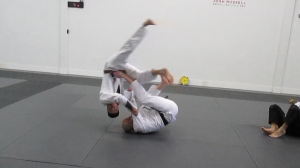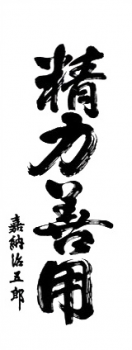Is Your Jiu-jitsu Efficient? You need Seiryoku Zenyo!
I was delighted with the positive response to last week’s article Got “Jiu”? What is the “Jiu” in Brazilian Jiu-jitsu? In fact some students of bjj told me that for the very first time they thought about the principle and went so far as to say that the article proved to be an epiphany for them and that they started to look at their own jiu-jitsu in an entirely new light!

We have merely scratched the surface of our discussion of the principle of “Ju” and I want to continue the theme with this week’s article.
I had a conversation on the mat a couple of years ago with the head instructor of my Gracie Barra academy, 2nd degree black belt Josh Russell. At the time I was having much difficulty with joint pain – chronically sore elbows and knees and I was seeking some advice on how I could get rid of the pain and train more often.
Prof. Russell teaches the majority of the classes at the academy each week and rolls multiple rounds with the toughest competitors in the academy each class. I asked him how he was able to manage that volume of training in a given week and still be able to show up for training the next day? He thought about the question for a moment and in his typical understated way answered simply “I try to be as efficient as possible every time I roll.”
Josh went onto explain a few methods by which he approached not only overall training in general but within each roll itself. Over the next week I really thought about that seemingly simple piece of advice and asked myself “How can I make my own jiu-jitsu more efficient?”
One of the main underlying philosophies of judo is the principle of “Seiryoku zenyo” (Maximum efficiency). Here is great quote on the meaning:
 “This is the core of the philosophy of judo. Do not waste!
“This is the core of the philosophy of judo. Do not waste!
Do not waste your mental, physical, and spiritual energy on things that do not accomplish your goals.
In Judo we try not to waste our energy when trying to throw someone.
There is a correct timing and position to executing a throwing technique.
If done correctly, the technique will work with almost no strength…like a hot knife through butter.
If done incorrectly, then you will find the technique difficult to accomplish and requires a tremendous amount of energy.”
More succinctly it may be stated: “Putting your energy to work most effectively.”
Now let us look at 3 ideas on how we can be more efficient in our own training:
1) An ounce of prevention is better than a pound of cure
Prof Bruno Fernandes of Gracie Barra Montreal was visiting our academy for a seminar and I asked him about timing an escape from the arm lock. Bruno offered the advice “It’s never a good idea to wait for the last minute to escape!”
Preventing the disadvantaged position in the first place is a much better strategy!
Let’s look at defending the guard for an example. At some point, while playing guard, the opponent will overcome our defense and pass our guard. Hanging onto the guard after the point where we have lost the position will allow the top opponent time to control our head, secure their grips, and apply their bodyweight in tight side control.
If instead, we earlier acknowledge that our guard is being passed, we can cease the now pointless guard grips and turn our effort to prevent the opponent from securing the grips that they need. If we start our escape (going to turtle or reguarding) BEFORE the opponent has established their hold down, we use FAR LESS ENERGY than we would attempting to escape a fully secured hold down. This is the single most common mistake I observe in white belts getting their guards passed and ending up caught in side control.
 2) Correct timing for the escape.
2) Correct timing for the escape.
This one was a HUGE one for me. When in the bottom of side control, when the top opponent has secured strong grips and flattened you out, it can be very difficult to escape. If the opponent has the sole intention of holding the position and not allowing the bottom to escape, it can be very frustrating and require tremendous physical energy to even move and start the escape.
If the opponent has obtained head control and is applying their bodyweight, even advanced practitioners can get stuck and exhausted on the bottom. The opponent has superior leverage and if their only purpose is to hold you there, they will likely succeed!
However, when the top player wishes to submit or change to another position, they frequently must switch their grips (thereby relinquishing some of their control) and move some of their weight (sacrificing some of their pressure). Keep your defensive posture on the bottom, relax your muscles, breathe and wait for your window of opportunity. I adjust the timing of my escape to that brief moment when my opponent shifts their bodyweight to attempt a submission, THEN go for the escape! This is much more efficient than struggling directly against an opponent who is only concentrating on holding you down.
 3) Correct leverages
3) Correct leverages
The first bjj seminar I ever attended, the Brazilian instructor said in his heavily accented English “If you are trying to do this…” and he demonstrated trying to force a kimura on someone who had a strong belt grip defense – grunting and feigning exertion – “THIS is NOT jiu-jitsu!” His message was if you are trying to use a lot of muscular strength to execute a technique, you must ask yourself, “Is this effective against a larger, stronger opponent? Will this only work against someone smaller and unable to withstand my superior muscular force?”
Your presupposition in learning any jiu-jitsu technique should be “Will this work against a stronger, larger opponent?”
You must always seek the optimal leverage to execute any movement. A perfect example I witnessed was when Prof. Russell was teaching the hook sweep (butterfly guard sweep using a single hook). He demonstrated that trying to move the opponent’s entire body over your body to execute the sweep was inefficient and required considerable muscular force. Instead, he explained, a quick scoot of his hips to the side created the optimal angle and leverage and the sweep was nearly effortless.
Now, imagine if you tweaked all of your techniques to employ the most efficient levers? How much energy would you save in the course of the match?
Devote some time to examining your jiu-jitsu with the philosophy of “Seiryoku Zenyo” to see how you can make your game more efficient.
Credits: Mark Mullen
GB Black belt from GB Calgary, Canada
Twitter: @MarkMullenBJJ
